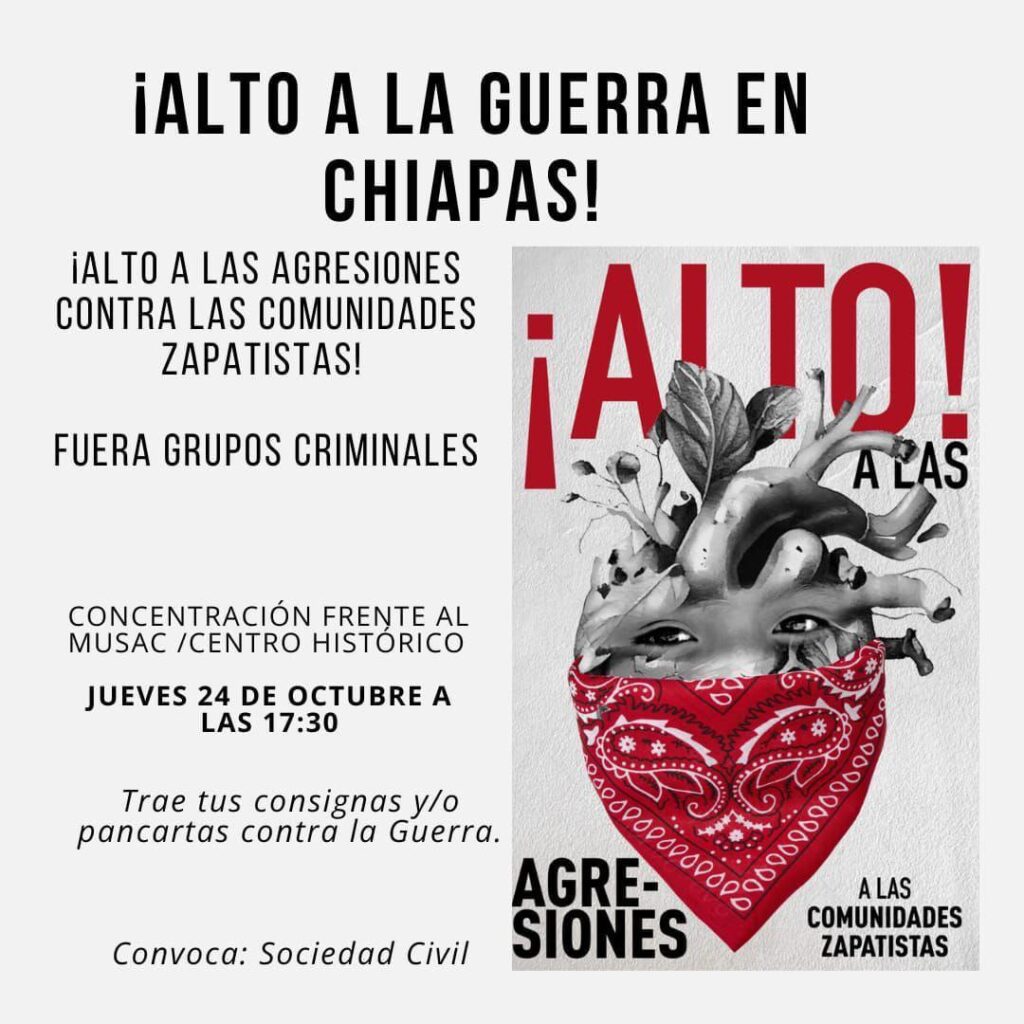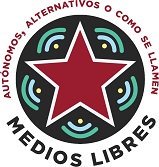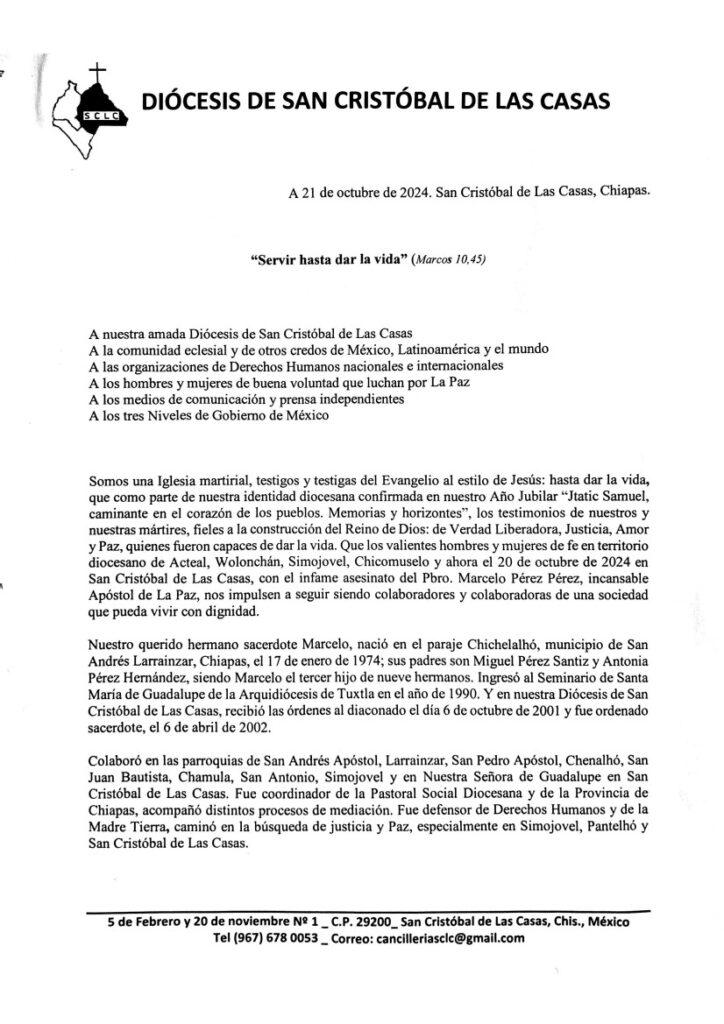
Topics

Pronunciamiento por el Alto a la Guerra en Chiapas ¡Las semillas del Padre Marcelo florecerán!
EXIGIMOS ALTO A LA GUERRA EN CHIAPAS
¡Las semillas del Padre Marcelo florecerán!
EL ESTADO NACIÓN MEXICANO
A LOS REPRESENTANTES DE LOS DIFERENTES NIVELES DE GOBIERNO
A LAS EMBAJADAS DE MÉXICO EN EL MUNDO
A LOS ORGANISMOS DEFENSORES DE DERECHOS HUMANOS
AL PUEBLO CREYENTE (DE CHIAPAS)
A LA DIÓCESIS DE SAN CRISTÓBAL DE LAS CASAS
A LA SOCIEDAD CIVIL INTERNACIONAL, NACIONAL, LOCAL
A LOS MEDIOS DE COMUNICACIÓN LOCALES, NACIONALES, INTERNACIONALES
El Grupo de Trabajo CLACSO Cuerpos, Territorios, Resistencias (GT CUTER) formado por universitarios(as), profesores(as), investigadores(as), activistas y artivistas de América Latina y el Caribe queremos mostrar, a través de este pronunciamiento, nuestra profunda tristeza, repudio e indignación ante el asesinato del sacerdote indígena tsotsil, Marcelo Pérez, incansable defensor de los derechos humanos y de los derechos de los pueblos, así como de los de la Madre Tierra y la vida. Hasta antes de su asesinato el Padre Marcelo era párroco de la Iglesia de Nuestra Señora de Guadalupe en San Cristóbal de Las Casas (Chiapas, México).
El pasado 20 de octubre, tras oficiar misa en la iglesia del barrio de Cuxtitali, el Padre Marcelo recibió varios impactos de bala que acabaron con su vida. El Padre Marcelo es ejemplo de la iglesia liberacionista que impulsó el Obispo Tatik Samuel Ruiz en la Diócesis de San Cristóbal de Las Casas desde la década de los años 1960s. Iglesia que ha sido un actor clave para entender muchos procesos de liberación indígena acaecidos desde el primer Congreso Indígena celebrado en 1974. Congreso impulsado precisamente por el obispo Ruiz y la Diócesis que entonces presidía. De hecho, a principios de este mes de octubre, la Diócesis de San Cristóbal celebró con las comunidades indígenas y religiosas los 50 años de dicho Congreso, parteaguas en la historia de lucha de los pueblos originarios de Chiapas.
Originario del municipio tsotsil de San Andrés Larráinzar, el Padre Marcelo se convirtió en incansable defensor de la paz ante el incremento de la violencia desatada por el crimen organizado en Chiapas. Participó -como parte de la Diócesis que era- en numerosas peregrinaciones y no calló ante las injusticias que vivía junto a su pueblo, a pesar de las constantes amenazas cargadas en su espalda. Desde 2015, mientras era párroco en el municipio de Simojovel (Los Altos de Chiapas), el Padre Marcelo fue beneficiario de medidas cautelares por parte de la CIDH debido a dichas amenazas. Precisamente, en un municipio cercano, Pantelhó, la violencia se incrementó debido a la penetración del crimen organizado. Ante dicha situación, el Padre Marcelo visibilizó a través de sus redes la existencia de armas, los hostigamientos y los desplazamientos, siempre denunciando cómo dicha situación afectaba de manera más profunda a las mujeres, niñ@s y ancian@s.
En 2021, como respuesta a la violencia del crimen organizado, apareció en el municipio de Pantelhó, el grupo de autodefensa denominado “El Machete”, a quien se le atribuyó la desaparición de 21 personas el 26 de julio de 2021. El 21 de junio de 2022, la Fiscalía General del Estado de Chiapas (FGE) emitió una orden de captura contra el Padre Marcelo, vinculándole a la desaparición de dichas personas, aunque no existían pruebas de su participación en los hechos delictivos. La fabricación de delitos no es nueva en Chiapas, tal y como lo han acreditado en varios informes el Centro de Derechos Humanos Fray Bartolomé de Las Casas y otros organismos y redes por la paz. A pesar de los esfuerzos de personas vinculadas a la Diócesis, como de organizaciones defensoras de derechos humanos que solicitaron el cierre de dicho expediente en su contra, la FGE no accionó la orden de aprehensión, pero tampoco archivó las actuaciones.
Las amenazas en contra de la persona del Padre Marcelo no han cesado en los últimos años, a pesar de los reiterados avisos que organizaciones nacionales e internacionales de derechos humanos han realizado visibilizando que su vida corría peligro. Y a pesar de recibir acompañamiento internacional por parte del Movimiento Sueco por la Reconciliación, SweFOR.
Ante todo, el Padre Marcelo decidió caminar al lado del pueblo, con la fe indestructible en que la defensa de la paz era más importante que su propia vida.
Nuestro corazón está con mucho dolor y tristeza porque el asesinato del Padre Marcelo es una prueba de lo que él mismo anunció en la peregrinación por la Paz que encabezó el pasado 13 de septiembre en la capital de Chiapas, Tuxtla Gutiérrez, donde afirmó: “Chiapas es una bomba de tiempo, hay muchos desaparecidos, muchos secuestrados, hay muchos asesinados por la presencia del crimen organizado”.
Las autoridades locales, estatales y federales no están siendo capaces de garantizar la seguridad y la vida de su población, ni la del Padre Marcelo, convertido hoy, lamentablemente, en un referente de la actual situación de guerra que sufre el territorio chiapaneco, como tantos otros territorios en México.
Nos solidarizamos con el dolor del pueblo en general, del Pueblo Creyente en particular, con los agentes de pastoral, con la Diócesis de San Cristóbal de Las Casas y con las comunidades y movimientos que él acompañó en vida; también abrazamos a su familia. Exigimos, con toda la fuerza que nos da la legitimidad social, al Estado mexicano y a los diferentes niveles de gobierno investigaciones expeditas, imparciales y efectivas, que hagan realidad la verdad y la justicia que el Padre Marcelo defendió con su propia vida.
Nos sumamos a las demandas hechas por las organizaciones indígenas y defensoras de
derechos humanos nacionales e internacionales, quienes claman:
1) Alto a la guerra en Chiapas.
2) Que se investigue tanto a los autores materiales como a los intelectuales del crimen del
Padre Marcelo.
3) El desarme y la desarticulación de los grupos corporativos criminales.
4) Que se dé un giro radical a la política de seguridad nacional y estatal.
5) Alto a la persecución, criminalización y asesinato de los y las defensores(as) de los
derechos humanos y de los(as) mediadores(as) por la paz.
¡Las semillas del Padre Marcelo florecerán!
Planeta Tierra
21 de octubre de 2024
Grupo de Trabajo CLACSO Cuerpos, territorios, resistencias

[24 Oct – San Cristóbal] Alto a la guerra en Chiapas
Nuestra lucha es por la vida
Convocamos a personas, que busca la paz con verdad y justicia a:
Manifestarnos contra la violencia que durante años ha estado azotando a nuestro terriorio, causando desplazamiento forzado de poblaciones enteras, masacres, secuestros, desapariciones, violencia feminicida, entre otras tantas atrocidades contra el pueblo de Chiapas y que en los últimos días ha causado fuertes sufrimientos como lo fue el asesinato del padre Marcelo Pérez Pérez y las agresiones a la comunidad zapatista “6 de octubre” en Ocosingo por parte de grupos armados que pretenden desplazar forzadamente a niñ@s, mujeres y hombres que por 30 han vivido la autonomía de forma pacífica.






